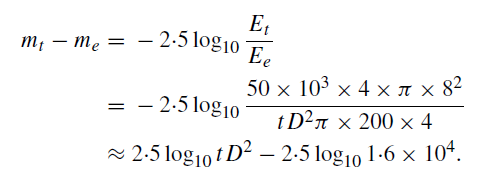


 الفيزياء الكلاسيكية
الفيزياء الكلاسيكية
 الكهربائية والمغناطيسية
الكهربائية والمغناطيسية
 علم البصريات
علم البصريات
 الفيزياء الحديثة
الفيزياء الحديثة
 النظرية النسبية
النظرية النسبية
 الفيزياء النووية
الفيزياء النووية
 فيزياء الحالة الصلبة
فيزياء الحالة الصلبة
 الليزر
الليزر
 علم الفلك
علم الفلك
 المجموعة الشمسية
المجموعة الشمسية
 الطاقة البديلة
الطاقة البديلة
 الفيزياء والعلوم الأخرى
الفيزياء والعلوم الأخرى
 مواضيع عامة في الفيزياء
مواضيع عامة في الفيزياء|
Read More
Date: 14-8-2020
Date: 1-9-2020
Date: 18-8-2020
|
Limiting magnitude
To a first approximation, a star image on a photographic plate can be considered to be a point. The total energy which is collected into the point is proportional to the apparent brightness of the star, the area of the collecting aperture and the integration time of the exposure.
We can, therefore, estimate the magnitude of the faintest star which can be recorded photographically in the following way.
The eye needs to receive approximately 200 photons s−1 in order for it to sense an image. By assuming that the pupil of the dark-adapted eye has a diameter of 8 mm, the energy arrival rate, Ee, is given by

We have already seen that a photographic star image requires an accumulation of 50×103 photons and this can be achieved by having an energy arrival rate at the image of (50 × 103)/t photons s−1, where t is the exposure time expressed in seconds. Thus, the energy arrival rate, Et , per unit area of telescope aperture is given by

where D is the diameter of the telescope expressed in mm. If we consider that Ee and Et are produced by stars of magnitudes me and mt respectively, Pogson’s equation allows us to form the relation

Now, Ee corresponds to the energy arrival rate of a star which can just be seen by the naked eye and, hence, by putting me = 6, the value obtained for mt corresponds to the limiting magnitude, mlim, of the star which can be recorded by a telescope of diameter, D (mm), and exposure time, t (s). Hence,
 (1)
(1)
As an example, consider the use of a 500 mm telescope and an exposure time of 103 s. The faintest star recorded as given by equation (1), is approximately

In practice, however, this simplified approach of evaluating the limiting magnitude cannot be applied generally because of the wide range in the choice of telescopes, photographic materials and the site conditions. The ultimate magnitude limit is, of course, set by the fog of the plate as a result of the sky background. Equation (1) may also give values which are too optimistic, as no allowance has been made for the transmission efficiency of the telescope or for the reciprocity failure of the emulsion. It was also derived on the assumption that the star images are point-like and this is not strictly true.
It has been found, in practice, that the detectability of star images on plates which have been exposed to the limit of the fog-level depends on the sizes and the images: a larger image can be detected more easily. Now the size of any image depends on the focal length of the telescope and, hence, for telescopes of the same aperture, the one with a longer focal length will allow fainter stars to be detected. In other words, the right-hand side of the equation expressing the value of the limiting magnitude should also contain a term whose increase is related to the focal ratio of the telescope. If the image has a truly extended form, such as a nebula, then its strength is again proportional to the area of the collector, i.e. ∝D2, and it is also inversely proportional to the square of the focal length, F2, of the telescope. The latter dependence results from the area of the image being proportional to the square of the focal length. The image illumination is, therefore, inversely proportional to the square of the focal ratio, i.e. ∝1/f 2. Hence, for a given emulsion, an extended object can be photographed by a range of telescopes with the same exposure, provided that the focal ratios of the instruments are identical. The actual size of each image depends on the plate scale which in turn depends on the focal length. Accordingly, a nebula of small apparent angular size, such as a galaxy, might be photographed by a large reflector at its prime focus in order to obtain a detailed image, while a nebulosity with larger apparent angular size might be photographed by a wide-field camera of small focal length. If the apparent brightnesses of the two objects are the same and the focal ratios of the telescopes identical, then the exposure times will be the same for the two photographs.



|
|
|
|
لخفض ضغط الدم.. دراسة تحدد "تمارين مهمة"
|
|
|
|
|
|
|
طال انتظارها.. ميزة جديدة من "واتساب" تعزز الخصوصية
|
|
|
|
|
|
|
مشاتل الكفيل تزيّن مجمّع أبي الفضل العبّاس (عليه السلام) بالورد استعدادًا لحفل التخرج المركزي
|
|
|